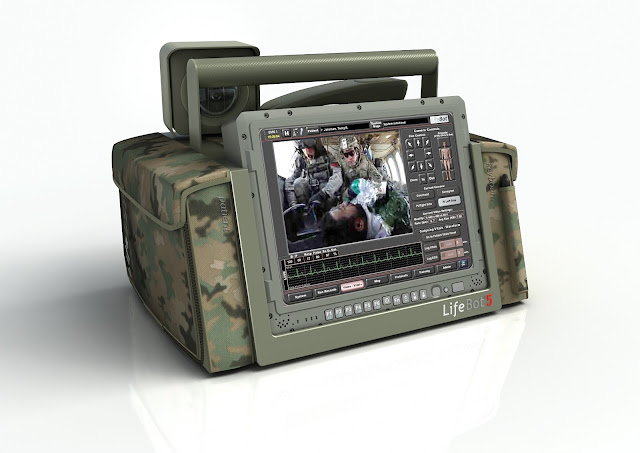 |
| The LifeBot 5 tm The new telemedicine device |
Post by Dr. Ramon Reyes, MD
 |
| The LifeBot 5 tm The new telemedicine device |
 |
| The LifeBot 5 tm The new telemedicine device |
The LifeBot 5 : The Game Has Changed. 15 Pounds of Portable Ruggedized Telemedicine
That May Be Used Anywhere at Anytime
Phoenix, AZ, USA October 22, 2012 : LifeBot, LLC announced that it is beginning deliveries of its new advanced telemedicine system called the LifeBot 5. According to the company, two state telemedicine programs have ordered or contracted for delivery of the advanced DREAMS™ telemedicine systems.
LifeBot acquired the exclusive world-wide license to DREAMS™ (Disaster Relief and Emergency Medical Services) and has reduced the system to a miniaturized lightweight portable unit that may be used anywhere at anytime. The original system was developed under DOD grants of $14 million from the Telemedicine and Technology Research Center (TATRC) and U.S. Army Medical Research and Materiel Command (USAMRMC).
The new LifeBot 5 promises to revolutionize the way remote care is delivered and reduce both the risks and costs of deploying telemedicine systems in both hospital-to-hospital and hospital-to-ambulance communications.
Faster Deployment: Reduced Costs Saving More Lives
The base collaboration LifeBot 5 is very affordable, beginning under $20,000. The system may be less than half of the cost of most existing telemedicine systems that have many less critical features. Being portable, the LifeBot 5 may be installed instantly and at less costs putting life-saving telemedicine systems on the fast-track to full scaled deployment.
The Intelligent Communications Manager (ICM)
The system is the only portable telemedicine system with critical wireless connectivity management on-board. Developed exclusively as a part of the DREAMS™ Project, the ICM transparently manages 4G, 3G, LTE, WiMax, Cellular, Wi-Fi, Satellite, and Data Radio connections automatically aggregating what works. This proven system gives new efficacy to mobile telemedicine and pre-hospital ambulance operations even in very low-bandwidth situations.
The Interceptor™ : Full Patient Monitoring Built-In
The LifeBot Interceptor™ is an on-board medical electronics module that allows for direct patient connection and full physiological monitoring. The system offers the largest display in the business, 10.2 inches diagonally. The need for a separate monitor and its associated extra patient connections are eliminated.
The LifeBot Interceptor™ compliments live video and voice transmissions with live patient monitoring, and remote data transmissions of live clinical waveforms for single lead ECG, 12-Lead ECG, HR, NIBP, dual invasive BP, SpO2 with plethysmogram, etCO2 with capnogram, tpCO2, and dual temperatures integrating popular MasimoSET® technologies.
Finally It's Your Data : 5-Second 12-Lead STEMI Transmissions
The LifeBot Interceptor™ intercepts critical data directly from the patient. This information is sent automatically "live" in just seconds and it is securely shared only with the parties involved. There is no need for expensive separate third-party servers or additional related expenses to hospitals.
12-Lead ECG reports are sent automatically. In addition, 12-Lead reports, in Adobe PDF formats, may be instantly emailed directly to interventional cardiologist's computers or cellphones. A cath lab "STEMI Alert" may be initiated from both the ambulance and hospital locations in just seconds.
Interact with Existing ePCR and Electronic Medical Record Systems
While the LifeBot 5 has the first live ePCR (Electronic Patient Call Report) system built-in, web browser interfaces are integrated to provide ready access to existing web-based ePCR systems and Electronic Health Record (EHR) systems.
Complete call reports, including 12-lead ECG reports, are generated in Adobe PDF formats which may be easily attached directly to patient records. The platform is ideal for achieving Health Information Exchange (HIE) objectives for use by Accountable Care Organizations (ACO) vieing for timely reimbursement.
Since the LifeBot 5 uses a standard SQL based on-board database server, patient information, including physiologic data, may be readily ported automatically into any medical record system.
Where is the Defibrillator?
LifeBot has patented new defibrillation technologies that will be available in the future. The LifeBot 5, however, has been designed to house the Philips FR3 miniature AED (Automatic External Defibrillator). Since the LifeBot 5 is a complete patient monitoring system, there is little need for a separate monitor defibrillator system, except for synchronized countershock and pacing procedures. Any existing defibrillator may be carried along-side the LifeBot 5 as desired.
Complete FDA Compliance
LifeBot, LLC is registered with the Food and Drug Administration (FDA). All medical device systems used by LifeBot are 510(k) premarket approved and compliant. The LifeBot 5 is one of the first systems to undergo registration under the new Class I Medical Device Data Systems (MDDS) classification.
LifeBot 5 : The Future
Unlike existing instruments, the LifeBot 5 is modular in construction so it may be readily adapted to new technologies or be easily upgraded as critical needs arise. LifeBot is taking specific steps to make the system even smaller and lighter. According to LifeBot CEO, Roger Lee Heath, "These are just the first steps towards a portable system design that will rapidly evolve. The LifeBot 5 system is already setting new standards for advancing remote care in the industry."











